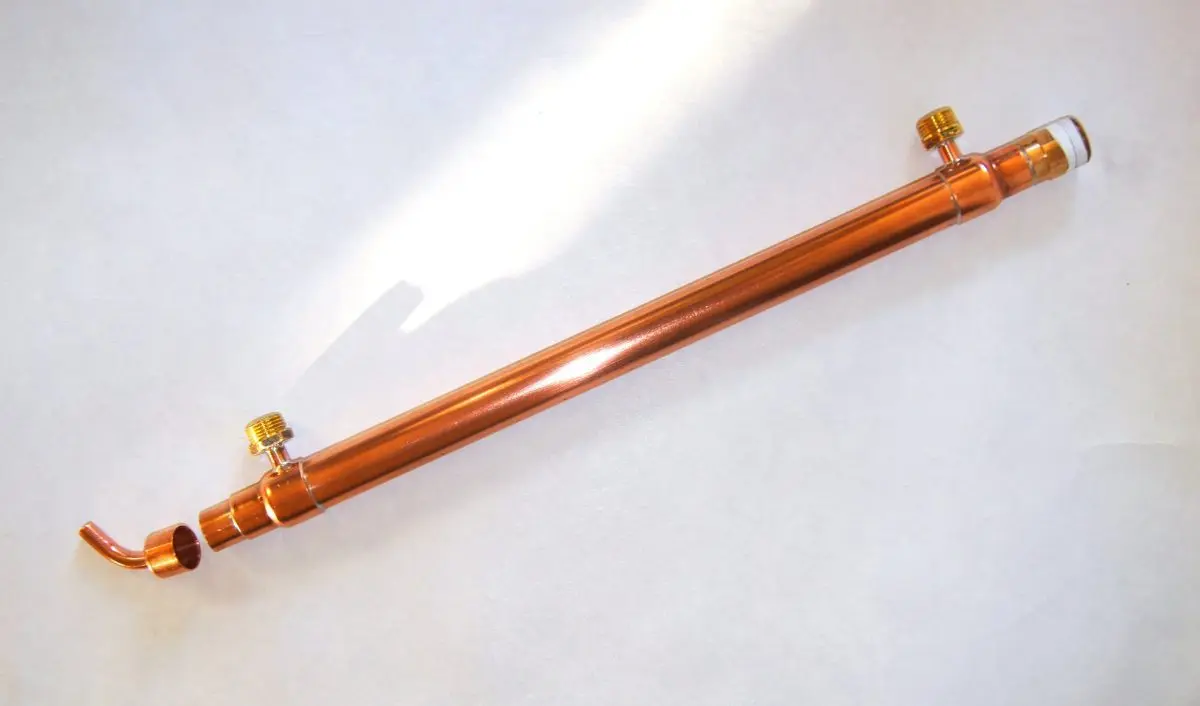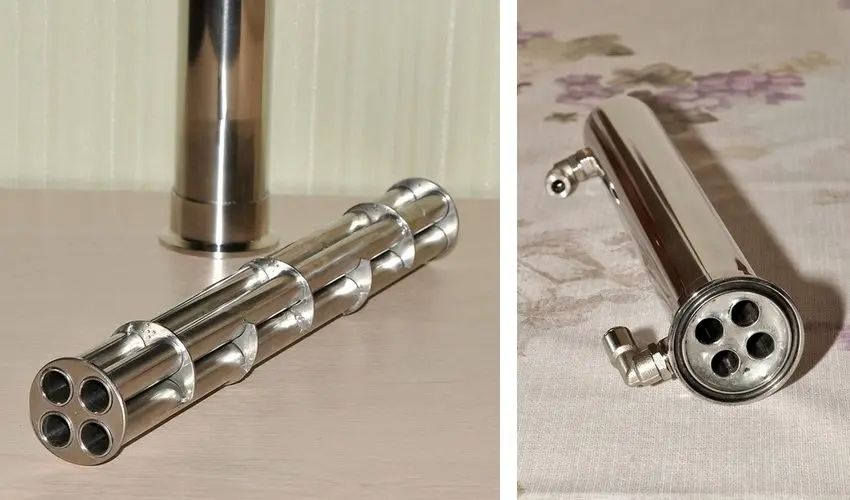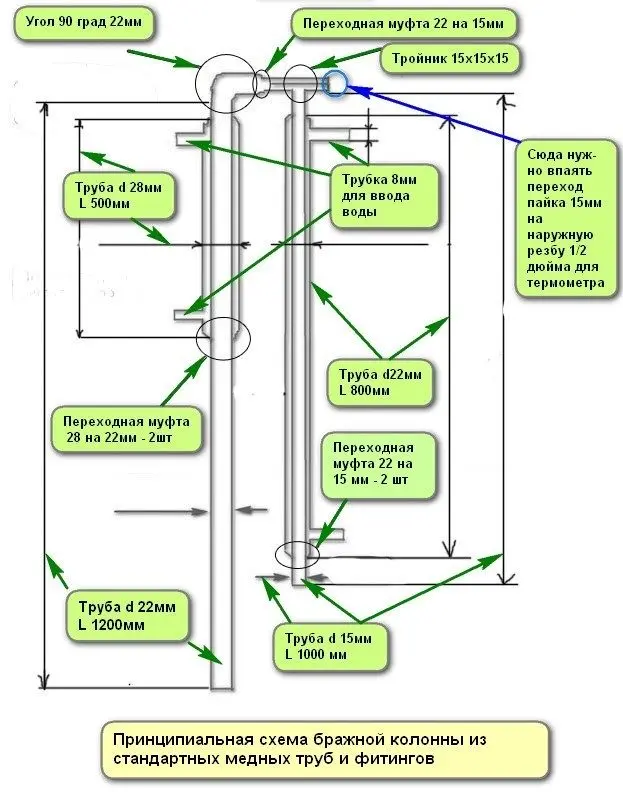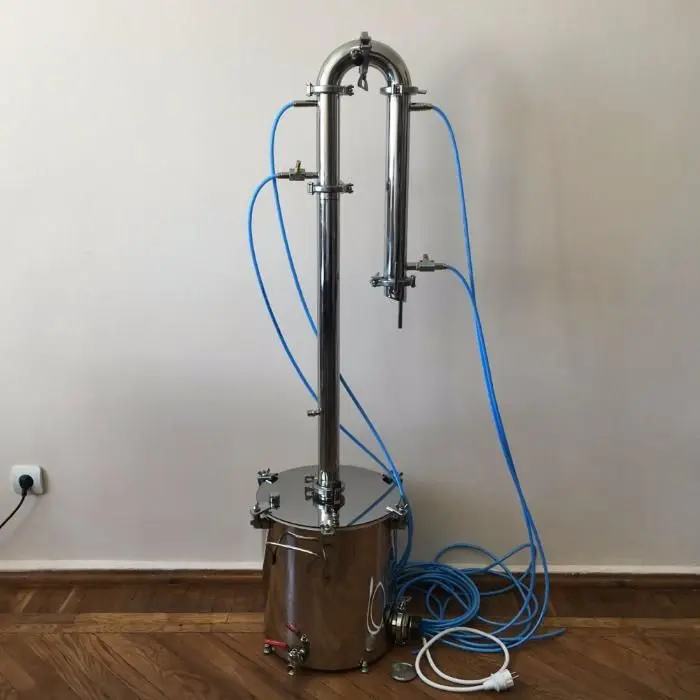Contents
The evolution from grandmother’s serpentine to home distillation columns followed bizarre paths, spawning many dead-end branches and “monsters”, but sometimes useful hybrid designs were developed. One of these devices was the beer column (BC), the popularity of which among home distillers is growing every year. However, such a device requires an understanding of the theoretical foundations and proper operation, otherwise the result will be disappointing.
The history of the appearance of the beer column
What did not suit the good old serpentine? First, poor performance. Secondly, even with fractional distillation, the distillate contains a significant amount of harmful impurities. A distillation column (RC) copes with these shortcomings, but has its own problems: expensive equipment, after rectification, the drink does not have the smell of the feedstock, and a distiller is still needed for the first distillation.
The advent of once-through and shell-and-tube refrigerators solved the performance problem. These designs of coolers made it possible to distill the mash into raw alcohol relatively quickly, and an empty pipe was added to the design to overcome splashing. So the distiller of the new generation has acquired a finished form.


The pipe served as a dry steamer – not allowing splashes from the cube, which are formed in wild phlegm, to fall into the selection. Such a distiller easily coped with any heating power available in everyday life. A small fortification of the product also appeared in order to enhance this, as previously considered, a useful property – a reflux condenser was used, which gave rise to a whole family of distillers with fortification, related by the common name: “mash column”.
Attention! The continuous beer column (NBK), despite the similar name, has a completely different purpose and principle of operation.
Film mash column
The main scheme was the BC with a shirt reflux condenser, shown in the figure.


Available materials, ease of manufacture and strengthening of moonshine up to 90-91% contributed to the growth in popularity of such a scheme. With operating experience, the main requirements were formulated.
A film mash column was considered good if:
- the diameter was 25-28 mm, and the height was 30 to 50 times the inner diameter;
- there was a sufficiently powerful and well-controlled dephlegmator capable of extinguishing the working heating power;
- there was a fine adjustment of the flow of cooling water to the dephlegmator using a needle valve;
- implemented a separate water supply to the refrigerator and dephlegmator;
- a thermometer is installed above the reflux condenser in the steam pipe;
- there was a sufficiently productive refrigerator to work with full heating power both in the second and in the first stage.
Working with the film column was not easy and required the owner’s constant attention. During the first distillation, the reflux condenser was not turned on so as not to increase the boiling time of the mash, but during the second distillation, the reflux condenser was already working, making it possible to select the “heads” drop by drop and strengthen the “body” up to 90%. True, it was not always possible to achieve the intended goals with the help of a reflux condenser, then heating was used, which eventually became the main one for the BC. However, the product obtained as a result of distillation on film BC seemed to enthusiasts to be much better than moonshine after fractional distillation on a conventional apparatus.
Euphoria can be explained by the fact that the high strength masks the unpleasant smell of the drink. True, after dilution with water up to 40-45%, all the shortcomings of the distillate manifested themselves in full in a couple of days. Users consoled themselves with the fact that they did not strive to obtain alcohol, but wanted to drink well-purified moonshine with the aromas of the raw materials.
Film column disadvantages
“Strong does not mean clean” – this simple idea did not immediately capture the minds of moonshiners, but there were sensible skeptics who gave the product for analysis. The results were amazing: laboratory testing showed that the removal of impurities on this equipment is a myth.
Moreover, if the film column still somehow allowed to select “heads”, then there was almost more fusel in the selection than in the feedstock. This made me think and understand how harmful impurities get into the selection, then determine the reasons and try to overcome them.
1. Sensitivity to water pressure. Even a slight decrease in the flow of water in the dephlegmator is enough for all intermediate harmful impurities accumulated in the pipe to instantly slip into the selection. It is enough to open the faucet in the bathroom or flush the toilet so that the water pressure in the system drops, and the drop-by-drop selection of “heads” turns into a vigorous stream.
Rational proposals fell like a cornucopia: stabilization with the help of pressure regulators, water supply through an intermediate tank under the ceiling or an aquarium pump, autonomous cooling systems, etc. In general, things that are very useful and applicable not only for BC.
It seemed that the problem was solved, but in addition to stabilizing the flow of the supplied water, it was also required to control the reflux ratio with its help, and this is very inconvenient due to the large inertia of the system.
2. Small holding and separating ability. Trying to fit coils or a couple of washcloths into the column improved things a little, but not enough to solve the whole cleaning problem. As a result, the “heads” were selected carelessly, and even despite the drop-by-drop selection, the necessary esters responsible for aroma were also removed along with harmful substances.
Due to the impossibility of concentrating the “heads” in the selection zone in large quantities due to the practically absent holding capacity, it was necessary to select them in excess, losing a significant part of the alcohol. The transition to the selection of the “body” by increasing the heating power instantly sent intermediate impurities accumulated in the pipe to the selection.
The situation was aggravated by the fact that during the selection of the “body” the separation fell to 2-3 plates and could not hold up the sivukh. When the temperature in the cube approached 90-92 °C, if they did not switch to the selection of “tails” in time, the remains of the fusel oil flew into the receiving tank, leaving only water in the “tails”.
Even in the best samples of moonshine obtained on film columns, the content of fusel oils is at least 1-2 thousand mg per liter, more often much more. Due to the design features of the film BC, the distillate turns out to be unbalanced – with a clear bias in the chemical composition towards the fuselage.
The emergence of the modern brew column
The solution to the problem of cleaning fusel oils matured quickly – you need to fill the drawer with a nozzle. As a result, the BK has turned into a mini RK (distillation column) with the same rules and equipment requirements. The differences remained only in the versatility of the design, which allows the use of BC for the distillation of mash. Also used is the traditional for BK selection by steam, although many distillers appreciated the convenience of liquid selection and installed it on their columns, while others began experiments with selection by steam to the dephlegmator.

After that, the BC in the classic form of a film column with a selection of steam above the dephlegmator solemnly marched to the museum of the history of moonshine, where it took pride of place. You can object: “Full is for sale!”. The answer is simple: you never know dealers and collectors of antiques who sell and bribe not only obsolete things, but also their fakes.
Requirements for a good mash column
In most cases, a modern BC has a column with a diameter of 40-50 mm and a height of 75 to 100 cm, as well as a cube of 20-30 liters, liquid extraction and automation. In general, this corresponds to the standards and requirements for the Republic of Kazakhstan, but the main thing remained for the beer column: the versatility of the design and the desire to obtain a well-purified distillate with the taste and aroma of the feedstock, which can be drunk immediately without a long correction-aging in oak barrels.
However, during operation, ordinary users had a problem: using standard rectification technologies during the distillation of mash, they received not the expected well-purified and fortified distillate, but dirty alcohol, which they called NDRF semi-contemptuously – under-rectified. It seemed that the evolution of the development of beer columns had reached a dead end.
Then BK fans began experiments on the use of low reflux numbers in the distillation of raw alcohol. Everything fell into place. Smaller volumes of vat bulk and short sides, which do not allow pure alcohol to be obtained on the BC, have become a strong point for the production of distillate. The high tsarga of the Republic of Kazakhstan has a separating ability that is excessive for the distillate, cutting off not only the superfluous, but also the useful.
The low side of the BC made it possible to implement the technology of a balanced reduction in the concentration of all impurities in the product with the removal of some that are definitely not needed. This was facilitated by the use of larger nozzles. So, for 50 mm BC, SPN 4 x 4 x 0,28 is used instead of 3,5 x 3,5 x 0,25 in the Republic of Kazakhstan. For certain tasks, tray columns and copper rings as packings have proven themselves well, but this is a topic for a separate article.
How to work on the beer column
Beginners often complain that despite their best efforts, they end up with pure alcohol on the beer column, and not a tasty drink. There is no universal technology, since many of the nuances of distillation depend on the design of the apparatus, however, following the basic rules, you can make a fragrant and well-purified distillate on the BC.
1. BK and RK are devices that implement heat and mass transfer technologies, so the requirements for preparing equipment for operation are almost the same for them. In order to confidently control the reflux ratio during operation, you need: stable, controlled heating and cooling, as well as good thermal insulation of the cube and column.
2. Calculate the planned rate of “body” selection. We proceed from the fact that the reflux number should not exceed 2. For example, if the operating heating power for a 50 mm column is 1700 W, then approximately 4,93 x 1,7 = 8,3 liters of liquid per hour evaporate from the cube. We must take away a third, and return two-thirds with phlegm back to the column and cube. This means that the planned selection rate is 2,8 liters per hour, and the reflux ratio is (8,3 -2,8) / 2,8 = 2. Greater accuracy is not required.
3. A long and dull selection of “heads”, adopted during rectification, removes not only aldehydes, but also esters responsible for the aroma of the drink. Therefore, “heads” should be selected no more than 2-3% of the AC (absolute alcohol) in bulk. The rate should be approximately 25-300 ml/h (about 10% of the “body” withdrawal rate).
4. We set the starting speed of the “body” selection equal to the planned one (in our example, 2,8 l / h). And after the start of the selection, we adjust it so that the yield strength is 90-91% with a bulk strength of 40%.
No more speed change! By the end of the “body” selection, the speed will drop anyway, and the strength in the stream will decrease to 87-88% (with a residual strength of raw alcohol in a cube of 5%). The speed compared to rectification is enormous, but this is precisely what allows medium esters and a moderate portion of higher alcohols to pass into the receiving container. You need to finish the selection of the “body” at a bottom temperature of no higher than 95 ° C.
5. If we distill grain raw materials, then we select the “tails” fractionally (2-3 portions of 100-150 ml each) at a speed two to three times less than the starting one when selecting the “body”. “Tails” will go the next day for blending or for further processing in the Republic of Kazakhstan.
The main thing is not to be afraid of a high selection rate: if you underestimate it, then the output will no longer be a good distillate, but poorly purified alcohol, which is quite suitable for a barrel – impurities are not completely removed, but only “slightly combed”, freed from excess fusel oil and aldehydes.
If the goal is a distillate for consumption without long exposure, then you can experiment with adjusting the reflux ratio, remembering that the higher the reflux ratio, the greater the degree of purification and approximation to alcohol.
For the distillation of sugar raw materials, only the maximum purification from all impurities and the distillation technology adopted in the Republic of Kazakhstan are suitable. If the bulk volume does not exceed 15-20 volumes of the packing in the column, this SPN packing is of the size corresponding to the diameter of the column, and the column itself is at least 1 meter high, there are chances to get quite decent alcohol from raw sugar alcohol on BC.
PS Thanks for preparing the material for the article to the user IgorGor from our forum.









